Here’s the officially reported coronavirus death toll through January 19. The raw data from Johns Hopkins is here.
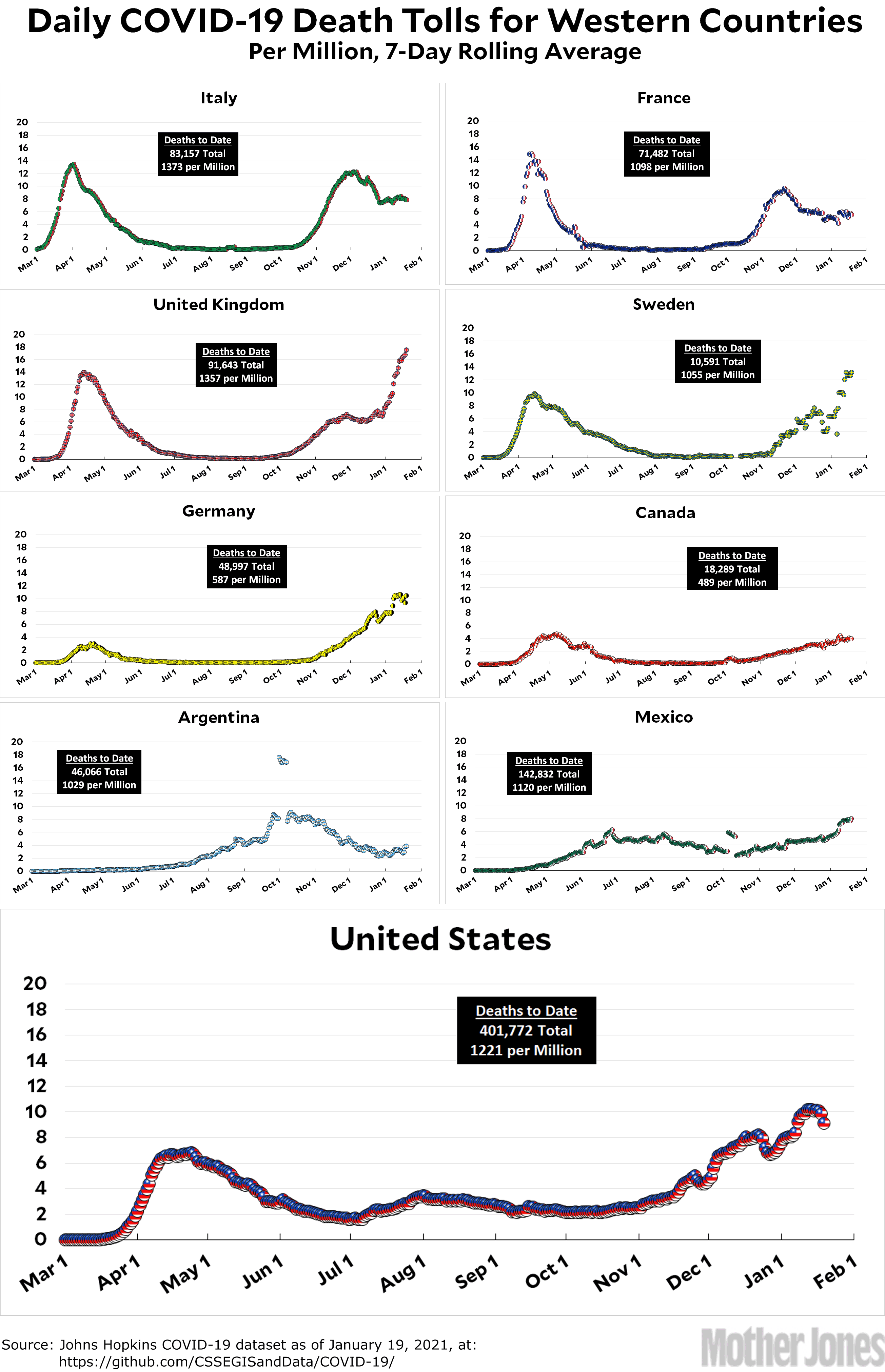

Here’s the officially reported coronavirus death toll through January 19. The raw data from Johns Hopkins is here.

Just when you think Fox News can hardly get any worse . . .
Fox anchor Maria Bartiromo: “A new report says that some far-right protesters have discussed posing as members of the National Guard to infiltrate the inauguration — the way Democrats infiltrated two weeks ago and put on MAGA clothing” https://t.co/pi4wyM1ZdN pic.twitter.com/nWA01TvHbr
— Media Matters (@mmfa) January 19, 2021
Maria Bartiromo will get a trial run as host of Fox’s new 7 p.m. weekday opinion show, which replaced a news hour https://t.co/wIKyIWjL7B pic.twitter.com/MKZflKEDPO
— Jeremy Barr (@jeremymbarr) January 18, 2021
Multiple sources tell me 16 long time Fox News digital staffers have been let go from the company this morning. Staffers calling this round of layoffs a “blood bath.”
— dianafalzone (@dianafalzone) January 19, 2021
Today’s layoffs at Fox’s digital operation are “part of the network’s larger effort to pivot its website from straight-news reporting to right-wing opinion content in the mold of Fox’s primetime programming,” The Daily Beast reports https://t.co/HSgfmfBaw4
— Brian Stelter (@brianstelter) January 19, 2021
So they’re purging the reality-based people, and elevating Maria Bartiromo, the clearest voice of Trump’s lies. https://t.co/p9yRJd9TAh
— Ben Smith (@benyt) January 19, 2021
The Siamese crocodile is watching you.

Some bad news from Israel, our champion vaccination jabber:
Israel’s coronavirus tsar has warned that a single dose of the Pfizer/BioNTech vaccine may be providing less protection than originally hoped, as the country reported a record 10,000 new Covid infections on Monday. In remarks reported by Army Radio, Nachman Ash said a single dose appeared “less effective than we had thought”, and also lower than Pfizer had suggested. By contrast, those who had received their second dose of the Pfizer vaccine had a six- to 12-fold increase in antibodies, according to data released by Sheba Medical Center in Tel Hashomer on Monday.
Hmmm. Maybe holding back doses for the second jab isn’t such a bad idea after all?
Here’s an odd thing. I was looking at the numbers for vaccinations and it turns out that on a log scale they’re rising on a straight line. What this means in semi-English is that the number of vaccinations per day is rising exponentially in both the UK and the United States. Here’s what this looks like assuming only a very small exponent:
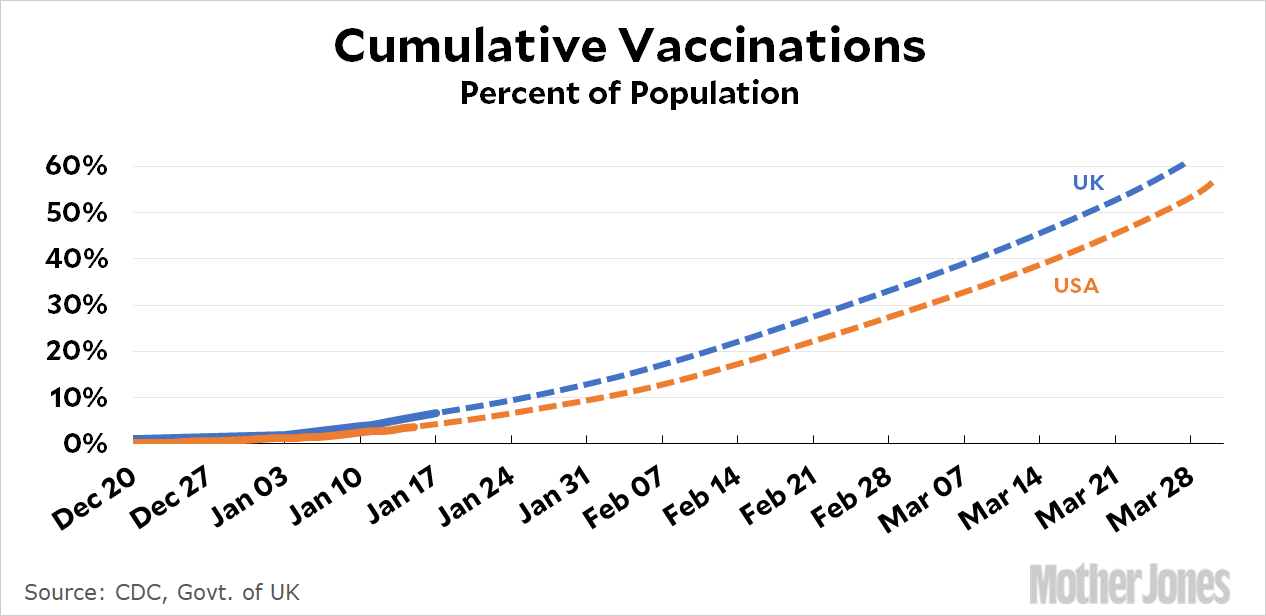
If you plot the log version of this, it suggests 100 percent coverage by the end of February. However, I don’t have the courage of my convictions and assumed a much more conservative growth rate. Even so, if we keep this up we’ll have half the country or more vaccinated by the end of March—including nearly 100 percent of the most vulnerable populations.
This does not even remotely match anything I’ve read about vaccination rates, which makes me hesitant to even post this. But what mistake am I making? The vaccine rollout has been getting better as time goes on, and it’s not unreasonable to assume that this will continue. At some point, of course, we’ll hit a ceiling due to availability of doses, but it’s not clear when that will happen.
In any case, is our long-term problem really lousy distribution or is it supply constraints? What’s going on here?
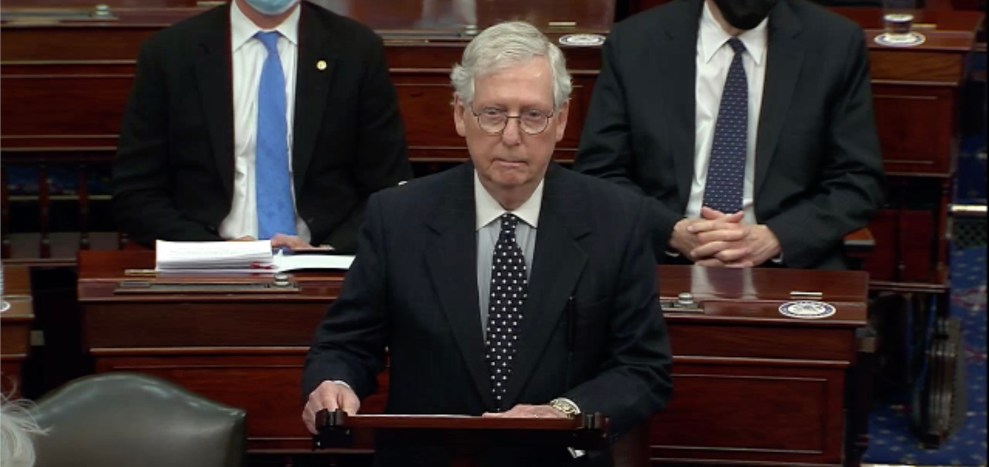
Consolidated News Photos/CNP via ZUMA
Mitch McConnell on the floor of the Senate today:
Senate Majority Leader Mitch McConnell (R-Ky.) on Tuesday pointedly blamed Trump for having “provoked” the violent mob that stormed the U.S. Capitol on Jan. 6….“The mob was fed lies,” McConnell said. “They were provoked by the president and other powerful people, and they tried to use fear and violence to stop a specific proceeding of the first branch of the federal government which they did not like. But we pressed on, we stood together and said an angry mob would not get veto power over the rule of law in our nation.”
It’s surprising which people have finally broken with Trump in the past few weeks. Bill Barr. Mick Mulvaney. Betsy DeVos. And now Mitch McConnell.
But it’s notable that McConnell still isn’t willing to condemn by name the biggest culprit of all: Fox News. But they’re still in power, aren’t they?
Here’s the officially reported coronavirus death toll through January 18. The raw data from Johns Hopkins is here.
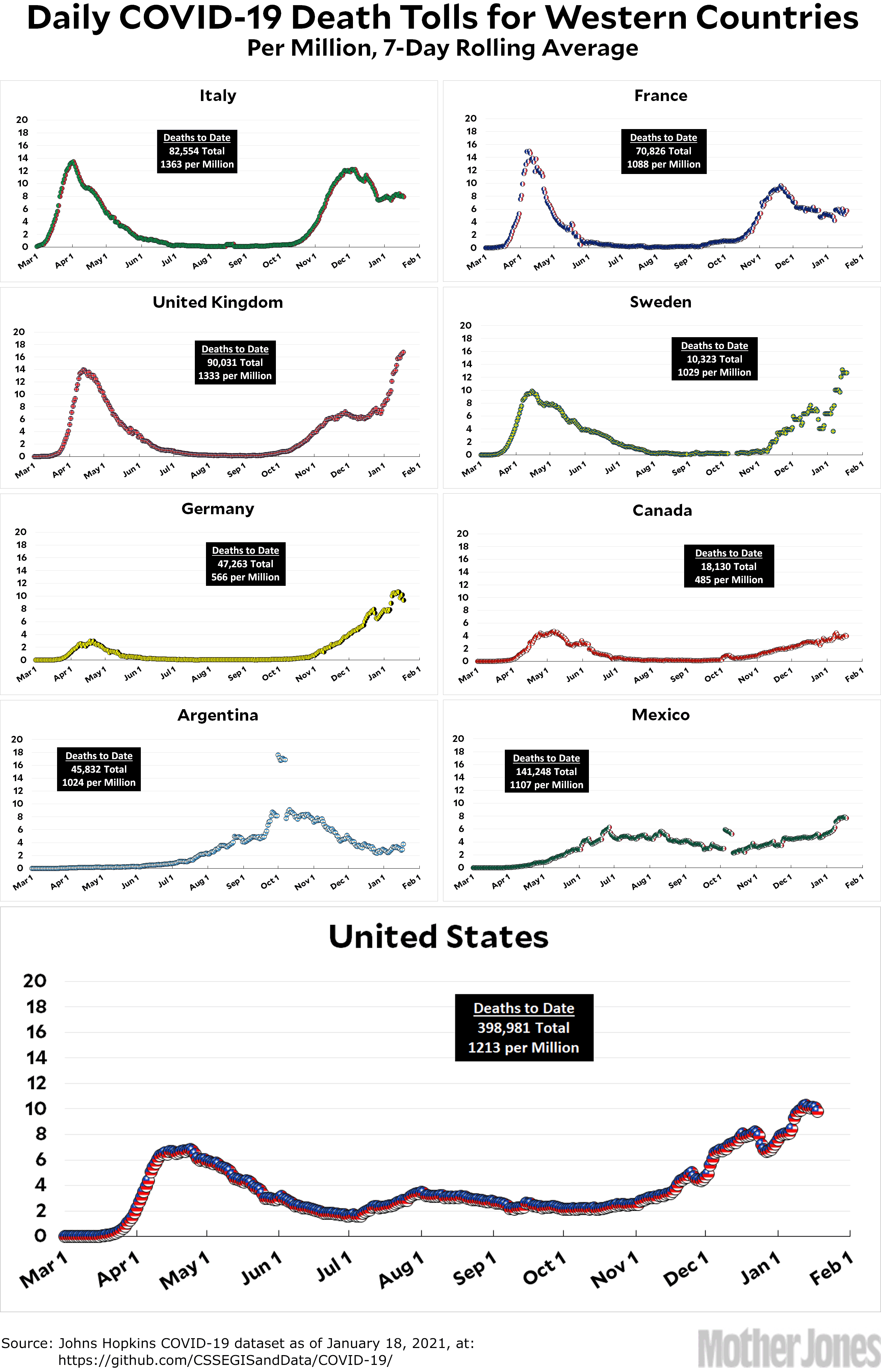
Here is something tentative but genuinely fascinating. I promise the payoff is worth it, but first it’s going to require a little bit of background about how the immune system works.
Human cells all contain proteins called human leukocyte antigens, or HLAs, which swim around and periodically latch on to invading viruses, which they bring to the surface of the cell. White blood cells, patrolling outside the cells, are always looking for stuff that doesn’t belong, and if an HLA presents an invader to the surface of the cell white blood cells immediately attack and destroy the entire cell. Conversely, if no HLA brings a virus to the surface, then its existence goes undetected and the immune system can’t attack it.
Now here’s the interesting part: there are dozens of different kinds of HLAs, and everybody has a different HLA profile. That’s one reason that if you and I both get sneezed on by someone with a cold, one of us might get sick while the other doesn’t. It means that one of us happened to have the right HLA to latch onto the virus while the other one didn’t.
And here’s the even more interesting part: different human populations have different average HLA profiles. This means that some populations are more resistant to certain diseases than others. For example, COVID-19.
In a recent paper, a team of researchers looked at 140 different HLAs, and in particular discovered that COVID-19 seemed to be sensitive to the ratio of the S and N types. Here’s the chart:
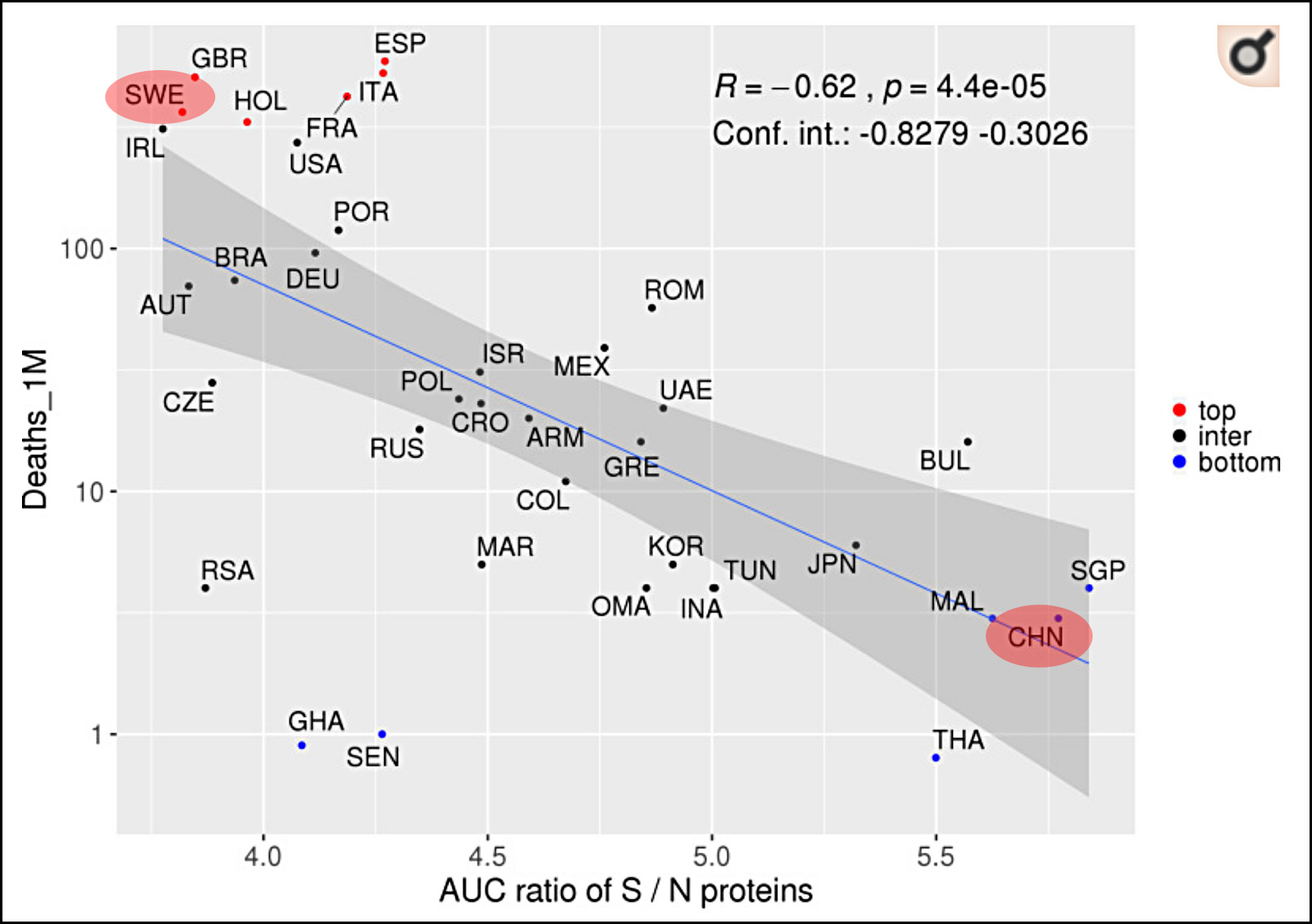
One of the great mysteries of COVID-19 is why China has been relatively unscathed. Aside from the initial outbreak in Wuhan, there have been hardly any cases in the entire country. But how can that be? Even with strong quarantine procedures, it’s simply not plausible that a fairly transmissible virus like COVID-19 could fail to spread widely in a country of over a billion people.
HLAs might be the answer. As you can see in the chart, the authors estimate that the S/N ratio for China is about 5.7, one of the highest in the world. That would suggest high resistance to the COVID-19 virus. At the other end, Sweden has an S/N ratio of 3.8, one of the lowest in the world. It’s possible that the “Swedish experiment” was never an experiment at all. They might have been doomed to a high COVID-19 infection rate no matter what they had done.
This is very preliminary research, and HLA profiles are certainly not the entire story. That said, if this is confirmed—or if other HLA profiles are identified that are associated with COVID-19—it might change our understanding of why infection rates are very different in different parts of the world.
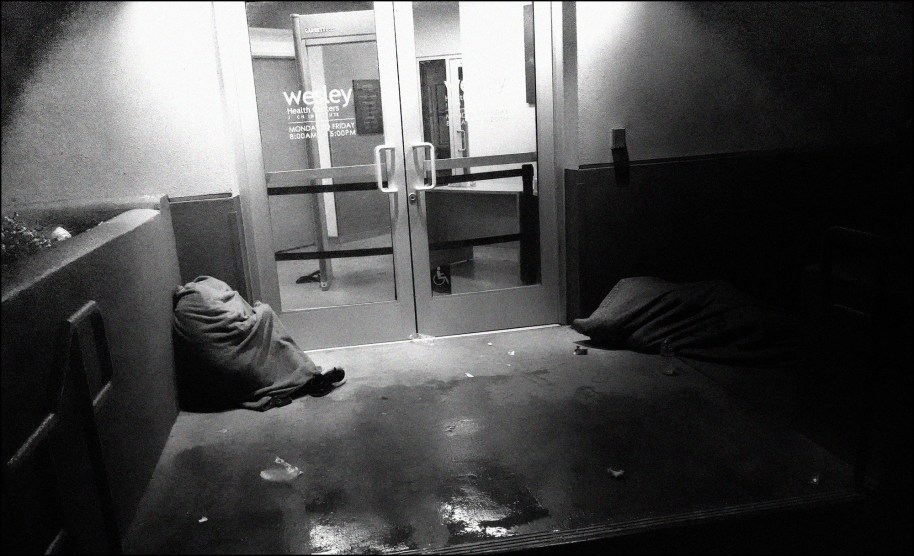
A pair of homeless people on Skid Row, about a mile from the Vignes Street project.Kevin Drum
As you probably know, Los Angeles has an enormous homelessness problem. Today, however, the LA Times reported some good news about a new homeless shelter being built downtown on Vignes Street:
When the last touches of landscaping are done next month, the 232-bed Vignes Street development will have shattered the axiom that homeless housing takes years to build and is exorbitantly expensive. From start to finish in under five months and at a cost of about $200,000 per bed, it has shaved years and hundreds of thousands of dollars off a traditional homeless housing project.
….Unlike traditional homeless housing projects that are either designed for permanent residency with services or for short-term shelter, the Vignes complex will have both. The two main buildings, constructed of once-used shipping containers, will have 132 units of permanent housing. The trailers, each divided into five units, will be for interim housing. The administrative building will house dining facilities, laundry and support services such as case management and counseling to serve both the permanent and interim residents.
I don’t quite understand the obsession with shipping containers, but whatever. If it works, it works. But how did it work so quickly? The problem with homeless shelters isn’t usually either money or the will to build them, it’s community opposition; building codes; environmental laws; and other rules specially tailored for the homeless that drive up costs and extend timelines. So what’s up with the Vignes Street project?
The bulk of the funding came from the federal CARES Act, allowing the county to sidestep the usual convoluted process of finding money for affordable housing. And the health emergency provided justification for exemptions from environmental review and competitive bidding. Another bonus was the 4-acre downtown parcel. The property had long been a factory that manufactured oil well equipment and later a machine shop. The buildings were leveled in 2018, and the county had bought the property as part of the jail replacement project that the Board of Supervisors later shelved in its decision to shift resources from jail to community care.
….There were also intangibles that motivated everyone involved, said Mark Pestrella, the director of public works….The authorization in [Hilda] Solis’ board motion to skip competitive bidding allowed Pestrella to seek out Bernards, a design and construction firm that he said was reliable and would work with the county “hands-on in a construction, not just contracting, relationship.”
Well, that explains it. It’s downtown in an industrial area next to the jail, so nobody objected. There were no strings attached to the money because funding came from the CARES Act. It was exempt from California’s lengthy—and typically litigious—environmental review process. The county already owned the property. And the board of directors allowed the project to skip competitive bidding, another routinely litigious process.
A lot of people don’t realize that it’s not construction or site selection or the dedication of public servants that slows down the construction of homeless shelters. Often it’s not even the money. Rather, it’s the massive tangle of rules and community resistance that simply can’t be ignored or sliced through like some kind of bureaucratic Gordian knot. If it weren’t for that, shelters ranging from tent encampments all the way to single-family apartments could be built quickly and cheaply to meet the needs of all different kinds of homeless people. Los Angeles just proved it.
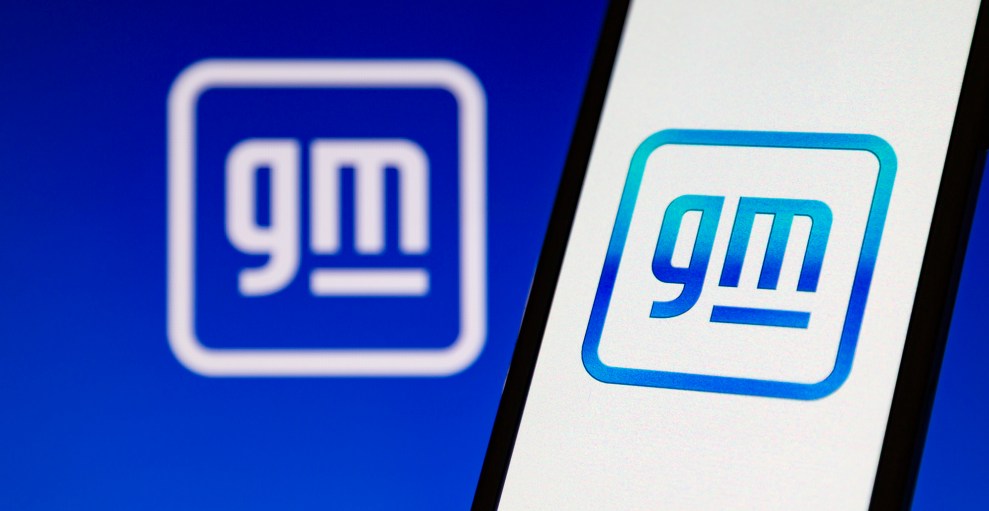
A new logo is fine, but how about doing something to really show that you care about your customers?Andre M. Chang/ZUMA
Max Boot says that it’s all very well to fight the social media sites which promoted the lie that Joe Biden stole the 2020 election, but if you really want to make a difference you need to go straight to the source: Fox News.
To its credit, Fox News acknowledged that Joe Biden won. But, reports Media Matters for America, “in the two weeks after Fox News called the election for Biden, Fox News cast doubt on the results of the election at least 774 times.” According to NPR, Fox Business host Lou Dobbs said Trump’s opponents in the government were guilty of “treason” and that it would be “criminal” for Republicans to recognize Biden’s victory. Fox News host Mark Levin told viewers: “If we don’t fight on Jan. 6 on the floor of the Senate and the House — and that is the joint meeting of Congress on these electors — then we are done.”
….James and Kathryn Murdoch, part of the family that controls Fox News, just called on “media property owners” to stop propagating “lies” that “have unleashed insidious and uncontrollable forces.” If James’s brother, Lachlan (co-chairman of News Corp and chief executive of Fox Corporation), and father, Rupert (executive chairman of News Corp and co-chairman of Fox Corporation), won’t listen, then large cable companies such as Comcast and Charter Spectrum, which carry Fox News and provide much of its revenue in the form of user fees, need to step in and kick Fox News off.
I appreciate the fighting spirit here, but cable companies aren’t going to boot off Fox News. Contracts alone would prevent them from doing so. But there’s another way: boycotts.
This may sound tiresome. It’s not as if there aren’t already people who are trying to lead boycotts of Fox News advertisers. But here’s the difference: if we want to make a difference, we should target one big advertiser and leave the rest alone for now. This is what the UAW does: they negotiate with one car company, which sets a pattern for their contracts with everyone else. And they don’t pick their victim randomly. They pick the company that seems most vulnerable to a strike threat.
So who would that be? Ideally, a company that (a) can’t afford to be associated even slightly with unAmerican activity, and (b) is not in the greatest financial shape. You also want a company that’s relatively easy to boycott. Big conglomerates, for example, make so many things that it’s hard to get people to boycott them all. Likewise, pharmaceutical companies make drugs that might be lifesavers for a lot of people. But then there’s . . . General Motors. Allstate. Applebees. Any one of those might be a good target.
Some Super PAC with a lot of money ought to pick one of these targets and go after them. It can hardly do any harm, can it? One way or another, we need to make Fox News into a pariah.